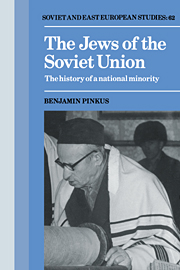2 - THE JEWS OF THE SOVIET UNION: THE YEARS OF CONSTRUCTION, 1917–1939
Published online by Cambridge University Press: 22 September 2009
Summary
The heading ‘years of construction’ should not be taken to imply that this period was entirely constructive for Soviet Jews. In fact, much damage was done to autonomous Jewish communities, to the Jewish religion, to Hebrew culture and to the Zionist and Socialist Parties; but when the achievements of this period are compared with the two later ones, which were unparalleled in their destruction of the Jewish nation, the choice of heading will be vindicated.
Soviet historiography, followed to some extent by the West, divides this period into three sub-periods: war communism, 1918 to 1921; the New Economic Policy, 1921 to 1927; and the period of industrialization and collectivization, 1928 to 1939. From the Jewish point of view, a different periodization is needed based on an analysis of official policy on nationalities and on internal Jewish national processes, as follows:
1917 to 1922: the search for solutions of the nationalities question;
1923 to 1932: the period of korenization (implanting, entrenching) in the new policy on nationalities;
1933 to 1939: the campaign against ‘nationalist deviations’, and the eclipse of autonomy for extra-territorial national minorities.
SOVIET NATIONALITY THEORY AND THE JEWS
For a state like the Soviet Union, based par excellence on ideology in the first period of its existence, a scrutiny of its nationality theory is necessary if we are to understand its official policy towards nationalities in general and the extra-territorial national minorities in particular.
- Type
- Chapter
- Information
- The Jews of the Soviet UnionThe History of a National Minority, pp. 49 - 137Publisher: Cambridge University PressPrint publication year: 1988



